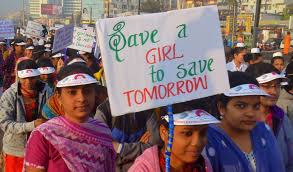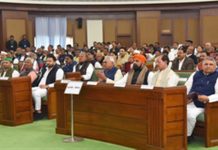
A recent report from the NITI Aayog said sex ratio at birth nationwide has dropped from 906 in 2012-2014 to 900 in 2013-2015. The number of girls born for every 1,000 boys In 17 States in the country witnessed a drop with Gujarat state performing the worst declining 53 points. While this is a highly disturbing trend, it is not new for India, which has seen a consistent downfall in girls as compared to every 1000 male children. The number of girls born is naturally lower than the number of boys because of the preference for for the male child.
Shockingly, In case of Haryana state Sex Ratio (SR) in male and female in eight districts including Rohtak, Mohindergarh, Sonipat Karnal, Charkhi Dadri, Kaithal, Bhiwani and Gurugram has been observed less than 900 girls as compared to 1000 boys. In-spite of state health department efforts there is no control over illegal ultrasound centres across the state involved in detecting pre-natal sex of unborn child in pregnant, which usually charge amount between Rs 30000 to 40000 for determination of sex of child in womb and there are several private hospitals and ‘Jhola-chhap’ doctors charging amount between Rs 80000 to Rs 1 lakh for termination of pregnancy in case of female child in the womb. However, the health department has arrested a large number of persons including owners of ultrasound centres involved in this illegal practice.
Government of Haryana had started ‘Beti Bachao-Beti Padao’ campaign from Panipat in year 2015 when in the year 2019 male-female sex ratio (SR) in newborns in Haryana state slashed down to 923 in 2019 and was recorded as 906 in July 2022. Information reveals, the use of ultrasonography and aborted female foetuses was first established through research in Bangladesh. Consequently, the Health Ministry of our country strictly banned the use of ultrasonography to determine sex of an unborn child. In February 2020, the High Court also banned gender detection to protect unborn female babies and pregnant women. Despite these efforts, gender detection of the unborn is still a common practice in the country. A study in this regard reveals that due to strictness in this illegal business in Haryana state, there are large number illegal ultrasound centres and few private hospitals still involved in this illegal practice in neighboring states Punjab, Rajasthan, Uttar Pradesh and Delhi, even large number of ‘Jhola-chhap’ doctors are doing this illegal business in rural places, residential houses and in mobile vans with portable ultrasound machines through a network of agents in Haryana.
A recent study reveals that male-female SR was observed as 945 in Jind district in the state followed by 931 in Sirsa and fatehabad districts, On the other hand male-female SR jumped from 893 to 931 in Kurukshetra and Jhajjar districts in past seven months. In fact, male-female SR winessed increase in seven districts in Haryana state and fall in 15 districts in the past about a year in the state. State health department Haryana study in December 2022 also reveals that in a period of seven months ta otal number of 2,93,926 children were born, which included 1,54,223 male child and 1,39,703 female child. The maximum number of fall in birth in newborns was found in Fatehabad, Rohtak, Charkhi Dadri, Gurugram, Kaithal, Karnal , Bhiwani, Nuh, Panchkula, Narnaul and Palwal districts. It is believed that male children are believed to be better earners and capable and caring for their parents in old age, while female children are often regarded as a financial burden due to dowry expectations during marriage, limited opportunities for education and career advancement and these misconceptions cause preferences for male children.












